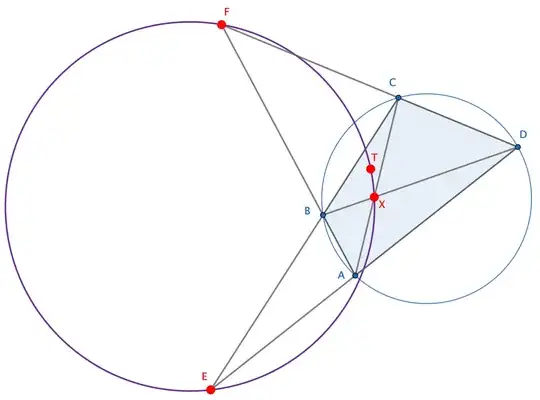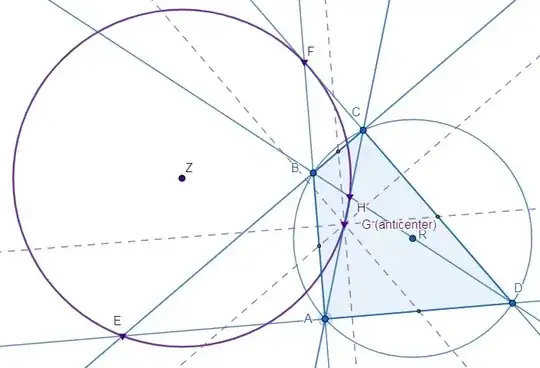Here is an "ugly" but straightforward solution with complex numbers. $WLOG$, assume $(ABC)$ to be the unit circle. Let $T$ be the anticenter and $X$ be the intersection of the diagonals of the quadrilateral $ABCD$. Lowercase letters denote the affixes.
 $\\$
$\\$
Since the anticenter is symmetric to the circumcenter in the centroid:
$$t=\frac{a+b+c+d}{2}$$
The intersection of $AB$ and $CD$ is given by:
$$f=\frac{(\bar{a} b-a \bar{b})(c-d)-(a-b)(\bar{c} d-c \bar{d})}{(\bar{a}-\bar{b})(c-d)-(a-b)(\bar{c}-\bar{d})}$$
Since $|a|=|b|=|c|=|d|=1$, this simplifies to:
$$f=\frac{a b(c+d)-c d(a+b)}{a b-c d}$$
Similarly:
$$e=\frac{a d(c+b)-c b(a+d)}{a d-c b} \; \; \text{and} \; \; x=\frac{a c(b+d)-b d(a+c)}{a c-b d}$$
It is not hard to show that $T, F, E, X$ are concyclic iff:
$$\frac{f-t}{e-t} \div \frac{f-x}{e-x} \; \in \; \mathbb{R} $$
Therefore, we need to show that:
$$\huge{ \frac{\frac{\frac{a b(c+d)-c d(a+b)}{a b-c d}-\frac{a+b+c+d}{2}}{\frac{a d(c+b)-c b(a+d)}{a d-c b}-\frac{a+b+c+d}{2}}}{\frac{{\frac{a b(c+d)-c d(a+b)}{a b-c d}-\frac{a c(b+d)-b d(a+c)}{a c-b d}}}{{\frac{a d(c+b)-c b(a+d)}{a d-c b}-\frac{a c(b+d)-b d(a+c)}{a c-b d}}}}\; \in \; \mathbb{R}}$$
To show this, we can substitute $\frac{1}{a}$ for $a$, $\frac{1}{b}$ for $b$, $\frac{1}{c}$ for $c$, $\frac{1}{d}$ for $d$ (recall $z\bar{z}=1$ for the unit circle), then show that the new expression is equal to the original one (since $z$ is a real number iff $z + \bar{z}=0$). Using Mathematica shows that the two expressions are equivalent. $ \; \; \blacksquare$
Here is what I checked in Mathematica.
True === FullSimplify[((((1/a)*(1/b)*((1/c)+(1/d))-(1/c)*(1/d)*((1/a)+(1/b)))/((1/a)*(1/b)-(1/c)*(1/d))-(((1/a)+(1/b)+(1/c)+(1/d))/(2)))/(((1/a)*(1/d)*((1/c)+(1/b))-(1/c)*(1/b)*((1/a)+(1/d)))/((1/a)*(1/d)-(1/c)*(1/b))-(((1/a)+(1/b)+(1/c)+(1/d))/(2))))/((((1/a)*(1/b)*((1/c)+(1/d))-(1/c)*(1/d)*((1/a)+(1/b)))/((1/a)*(1/b)-(1/c)*(1/d))-(((1/a)*(1/c)*((1/b)+(1/d))-(1/b)*(1/d)*((1/a)+(1/c)))/((1/a)*(1/c)-(1/b)*(1/d))))/(((1/a)*(1/d)*((1/c)+(1/b))-(1/c)*(1/b)*((1/a)+(1/d)))/((1/a)*(1/d)-(1/c)*(1/b))-(((1/a)*(1/c)*((1/b)+(1/d))-(1/b)*(1/d)*((1/a)+(1/c)))/((1/a)*(1/c)-(1/b)*(1/d)))))==(((a*b*(c+d)-c*d*(a+b))/(a*b-c*d)-((a+b+c+d)/(2)))/((a*d*(c+b)-c*b*(a+d))/(a*d-c*b)-((a+b+c+d)/(2))))/(((a*b*(c+d)-c*d*(a+b))/(a*b-c*d)-((a*c*(b+d)-b*d*(a+c))/(a*c-b*d)))/((a*d*(c+b)-c*b*(a+d))/(a*d-c*b)-((a*c*(b+d)-b*d*(a+c))/(a*c-b*d))))]
More detailed explanations of the formulas I used can be found in Evan Chen's this article.


There is a simple way to check whether a point or a circle related to a triangle is new or not. For instance, X(1116) = CENTER OF THE LESTER CIRCLE. Is there a similar database for special points related to the quadrilaterals? – A Z Jun 04 '21 at 13:56
The circle N'N"N"' also goes through Hon pg 254 of https://www.jstor.org/stable/pdf/1967118.pdf, and the reference to a paper by Kantor. This translates in your case toThe circle EFH also goes through G– brainjam Sep 16 '21 at 14:00Clawson Point. In the JSTOR reference in the previous comment it is called theorthic center– brainjam Sep 16 '21 at 14:10